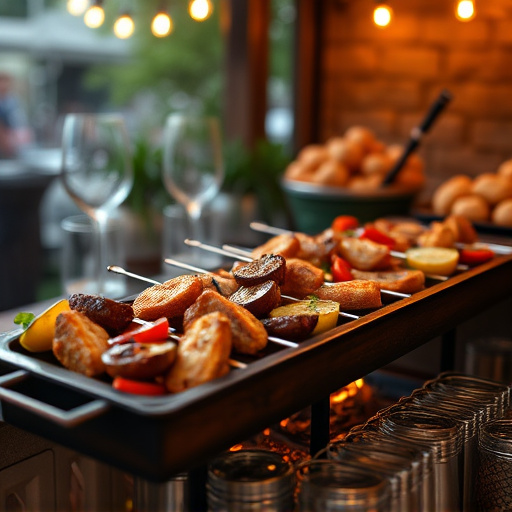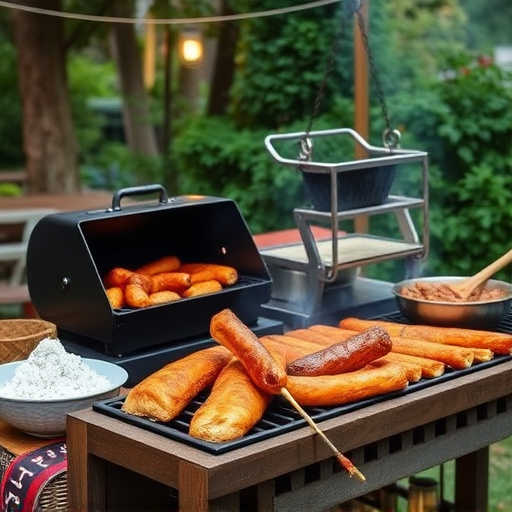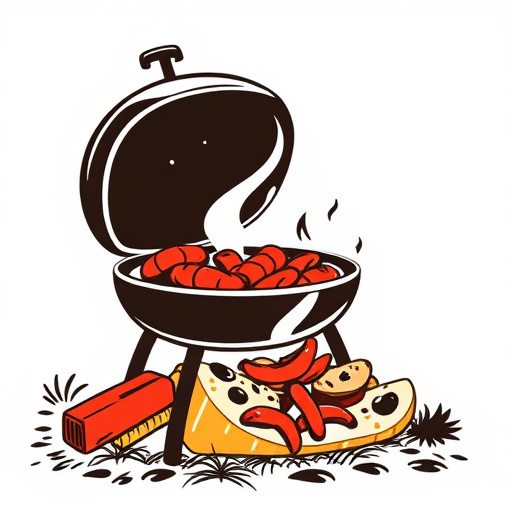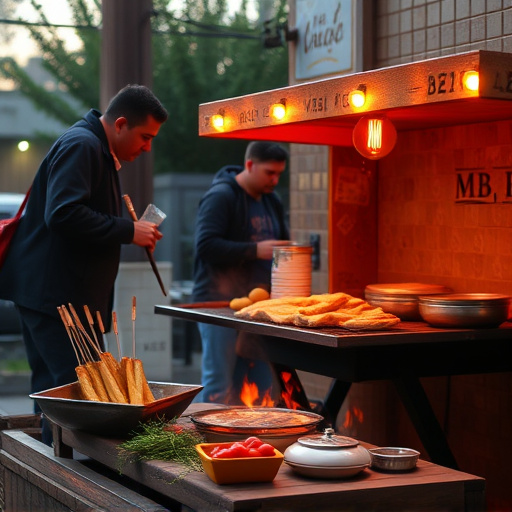Mastering the art of BBQ pork ribs starts with understanding cut characteristics (baby back vs. spare) and their cooking requirements. Craft a personalized dry rub with balanced sweet, smoky, and savory notes to elevate flavors naturally. Pat ribs dry, apply rub lengthwise, massage gently, and rest for optimal flavor development. Achieve tender results through slow smoking or quicker methods like grilling and baking, adjusting heat and timing accordingly. Customize rubs with unique ingredients for a tailored flavor experience that satisfies your taste preferences.
“Unleash your inner BBQ master with our guide to crafting the perfect homemade rub for pork ribs! This ultimate cooking companion takes your ribs from average to extraordinary. We’ll delve into the science behind pork rib cuts and their distinct flavors, then show you how to create a dry rub that’s both simple and complex. From essential ingredients to application techniques, we’ve got your back. Whether you’re a seasoned chef or a novice cook, this BBQ pork rib recipe will transform your ribs into a mouthwatering masterpiece.”
- Understanding Pork Ribs: The Cut and Its Unique Flavors
- The Magic of Dry Rub: A Simple Yet Powerful Seasoning Blend
- Essential Ingredients for a Mouthwatering BBQ Pork Rib Rub
- Creating the Perfect Consistency: How to Formulate Your Rub
- Applying the Rub: Techniques for Maximum Flavor Infusion
- Cooking Methods and Times: Achieving Tender, Juicy Ribs
- Variations and Customization: Making Your Rub Personal
Understanding Pork Ribs: The Cut and Its Unique Flavors

Pork ribs are a beloved treat in the BBQ world, offering a tender and flavorful experience. When preparing a delicious BBQ pork rib recipe, understanding the cut is key to unlocking their unique taste potential. Ribs come in various cuts, each with its own distinct characteristics. Typically, they are divided into sections, such as baby back or spare ribs, determined by the bone structure and meat attachment.
The cut of the ribs greatly influences the cooking process and final flavor profile. For instance, baby back ribs have a smaller bone structure and tend to be more lean, requiring a slower cook to ensure tenderness. On the other hand, spare ribs are known for their hearty, meaty texture due to the larger rib cage attachment, making them ideal for quicker, high-heat cooking methods. This knowledge allows BBQ enthusiasts to tailor their cooking techniques, ensuring the ribs become succulent and mouthwatering, ready to be slathered in a homemade rub for an unparalleled flavor explosion.
The Magic of Dry Rub: A Simple Yet Powerful Seasoning Blend

The Magic of Dry Rub: A Simple Yet Powerful Seasoning Blend
Dry rubs have long been a favorite among BBQ enthusiasts for their ability to pack a serious punch of flavor into every bite of your meat. When it comes to BBQ pork rib recipes, a well-crafted dry rub is the secret weapon that can transform ho-hum ribs into mouthwatering delicacies. With just a few simple ingredients, you can create a seasoning blend that enhances the natural juices and tenderness of the pork, resulting in a taste explosion with every slathering of sauce.
This DIY approach allows for endless customization based on personal preferences, from spicy heat to sweet and smoky notes. The beauty lies in its versatility—it can be used as a pre-cooking rub to infuse flavors deep into the meat or as a post-cooking seasoning to add that extra layer of deliciousness. Whether you’re a seasoned BBQ pro or just starting out, mastering your own dry rub is a game-changer for any BBQ pork rib recipe.
Essential Ingredients for a Mouthwatering BBQ Pork Rib Rub

When crafting a mouthwatering BBQ pork rib rub, there are key ingredients that elevate the flavor profile and transform your ribs into a culinary delight. A blend of spices is essential, with a mix of sweet, smoky, and savory notes being particularly effective. Brown sugar adds a rich, caramelized sweetness while also helping to create a crispy, caramelized crust on the rib surface. Paprika, both smoked and regular, imparts a robust smokiness that defines BBQ flavors.
Garlic powder enhances the umami taste, balancing the sweetness and smokiness. A pinch of salt and pepper are non-negotiable, acting as the foundation for the rub’s complexity. Ground mustard adds a tangy zing, cutting through the richness. For an extra kick, cayenne pepper or chili powder can be included, but adjust to your preferred heat level. These ingredients combine to create a robust, aromatic blend that promises to transform your pork ribs into a true BBQ masterpiece.
Creating the Perfect Consistency: How to Formulate Your Rub

Creating the perfect rub for your BBQ pork rib recipe is an art that involves balancing spices to enhance, rather than overpower, the natural flavors of the meat. The consistency of your rub plays a crucial role in its effectiveness; it needs to stick well to the ribs while also allowing for some moisture penetration. Aim for a coarse, free-flowing texture by combining brown sugar, salt, paprika, garlic powder, and cayenne pepper in a bowl. This blend should be able to cling to the rib surface without packing on too heavily. Adjusting the ratios of these ingredients is key; start with equal parts sweetener and salt as a base, then add spices gradually until you achieve your desired heat level and smokiness. For a richer, more complex taste, incorporate herbs like thyme or rosemary, ensuring they’re finely chopped to ensure even distribution. The rub should be moistened slightly with oil or vinegar to help it adhere to the ribs during the slow-cooking process, resulting in tender, flavorful meat that melts in your mouth.
Applying the Rub: Techniques for Maximum Flavor Infusion

When applying your homemade rub to pork ribs, the goal is to coat them evenly and generously for maximum flavor infusion. Start by patting the ribs dry with paper towels; this step ensures that the rub adheres better. Then, apply the rub in two directions—lengthwise and across the grain—to cover both sides of each rib. For extra tanginess, consider massaging the rub into the meat gently with your hands.
For best results, let the ribs sit for at least 30 minutes to an hour before cooking. This resting period allows the spices to penetrate the meat, enhancing its natural flavors. You can also wrap the ribs tightly in plastic wrap or store them in an airtight container in the refrigerator overnight for a more profound taste development, often referred to as a dry rub marinade.
Cooking Methods and Times: Achieving Tender, Juicy Ribs

When it comes to cooking BBQ pork ribs, the method and timing are key to achieving that perfect combination of tender meat and juicy flavors. The traditional approach is slow-smoking, which takes time but ensures the ribs cook evenly. This method involves low and steady heat, allowing the collagen in the meat to break down gradually, resulting in tender, fall-off-the-bone ribs. For a quicker option, you can opt for grilling or baking, but these methods require careful monitoring to prevent overcooking, which can dry out the ribs.
A good rule of thumb is to start with preheated oven at 300°F (150°C) for about an hour, then switch to a higher temperature like 400°F (200°C) for an additional 30 minutes to finish cooking. For grilling, aim for indirect heat and maintain a consistent temperature throughout the cook, allowing the ribs to gently simmer until tender. The timing may vary depending on the size of the ribs and your desired level of doneness, but patience is key in achieving those delectable BBQ pork rib recipes that will satisfy any meat lover.
Variations and Customization: Making Your Rub Personal

When it comes to crafting a homemade rub for BBQ pork ribs, the beauty lies in its versatility and customization potential. This allows you to tailor the spice blend to your exact preference, whether you’re a fan of smoky, sweet rubs or prefer a more heat-forward approach. Start with a basic dry rub recipe, combining common spices like paprika, brown sugar, salt, pepper, garlic powder, and onion powder. From there, feel free to experiment by adding unique ingredients such as chili powder for a kick, dried herbs like thyme or rosemary for an earthy twist, or even cinnamon for a surprising sweet-savory combo.
For the BBQ pork rib recipe, consider your desired level of heat and sweetness. You can increase the sugar content for a more caramelized, sticky glaze, while reducing it will result in a drier rub with a sharper spice profile. Don’t be afraid to play around with different ratios until you find the perfect balance. Personalization is key; make it yours by reflecting your taste preferences, ensuring each bite of those mouthwatering ribs offers an explosion of flavors tailored just for you.
